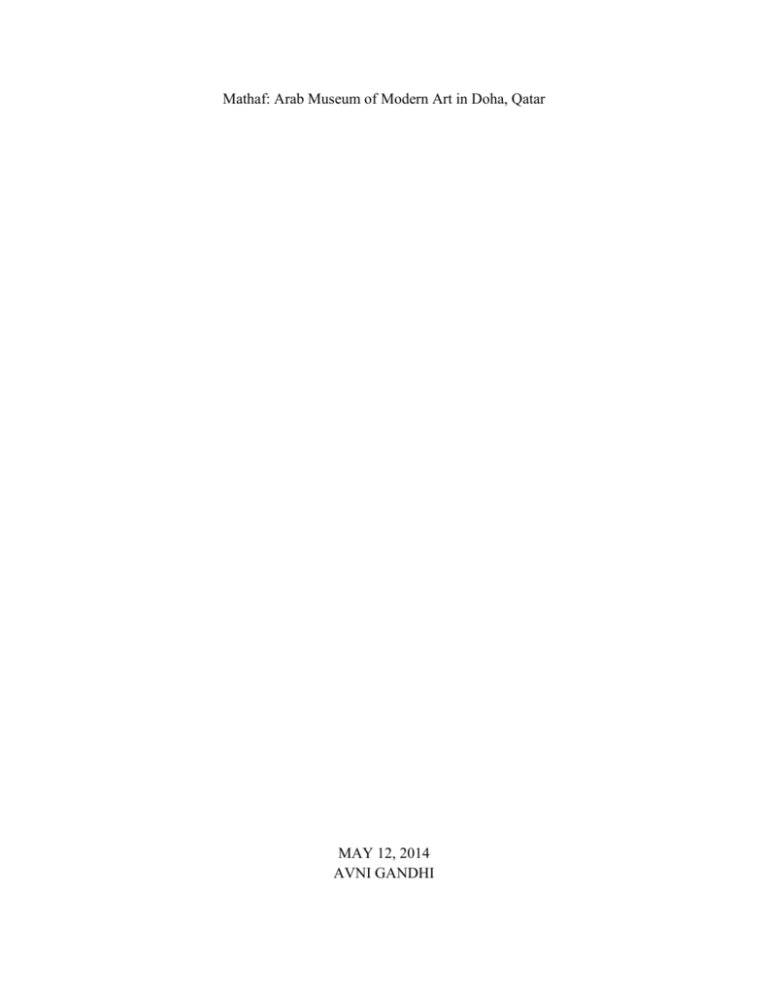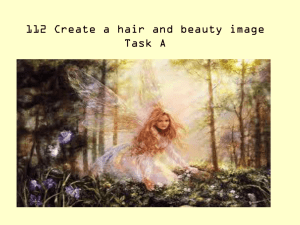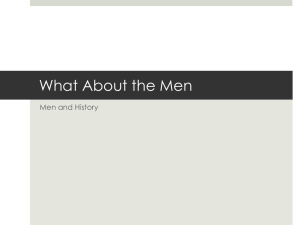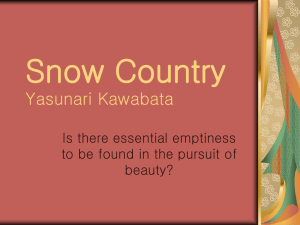Big History and the Public Purpose of Beauty
advertisement

Mathaf: Arab Museum of Modern Art in Doha, Qatar MAY 12, 2014 AVNI GANDHI Gandhi 1 MATHAF Museum is an Arab Museum of Modern Art located in Doha, Qatar. The collection was founded by Sheikh Hassan Al Thani. Al Thani is a Qatari artist, collector, researcher, and educator. Currently, he is the Vice Chairperson of Qatar Museums Authority. Qatar Museums Authority is the current owner of Al Thani’s collection in Mathaf. Al Thani’s vision was to build a collection of distinguished Arab art that would become a good resource for the public, such as scholars, students and art-lovers. Al Thani said, “Part of the mission of Mathaf is to expand people’s ideas about art and culture in this region-to show that the story is bigger, more exciting and more surprising than might be supposed” (Mathaf). In 1986, he purchased his first painting that would initially start his collection. 28 years later, he is the owner of over 6,000 artworks that spans the phases of modern art from 1840 to present-day. In 1994, Al Thani opened a private museum and started sponsoring artists from the region. The purpose of the museum was to offer the world an Arab perspective on modern and contemporary art. 10 years later, his entire collection was transferred to the new and current owner, Qatar Museums Authority.The collection started when Al Thani bought his first painting, an upside-down pyramid by Yousef Ahmad. His collection includes artists of all Middle Eastern countries, mainly from Qatari, Lebanese, Egyptian, Syrian, and Iraqi artists. There is no specific theme throughout the collection, except for the fact that it is contemporary and modern art. Big History is the history of the universe from the Big Bang to the present. Many of the exhibits at Mathaf have a connection with the thresholds of Big History. Threshold 1 is about the start of the universe. The theory is that the universe was created out of nothing; however, no one really knows if there really was nothing before. A painting that would connect to this would be Movement in Space (2000) by Salim Al Dabbagh. Movement in Space shows 5 “panels” that go from a lighter color to darker and have some scratches in it too. There’s a big stroke that goes Gandhi 2 through the entire painting horizontally. This painting could be represented as the creation of the universe. This is beautiful because it’s an abstract way of showing the creation of the universe through the use of light and dark shades of white and black. It gives people space to interpret it however they choose to. Threshold 2 is about the origin of galaxies and stars. Stars are made up of hydrogen and helium atoms and their nuclei. In order for a new star to be formed, there are three conditions that must be met: gravity, matter, and differences in the distribution of matter. An artwork that represents this threshold well is Title Unkown (1970) by Farid Belkahia. This artwork is beautiful on its own just because it uses traditional materials such as leather and natural minerals. Belkahia stretches the leather into large abstract works of art. Threshold 2 is about the origin of chemical elements and the artist uses elements in his work. The beauty is in the curves of the elements that have a covering of beautiful gold leather. It almost looks like a block of gold. Also, there is small stitching on the sides and the top and bottom of the artwork. Threshold 3 represents the death of stars and the creation of heavier elements. The death of stars occurred when they ran out of hydrogen to convert to helium and had to start converting other elements. This led to the creation of new chemical elements. Construction by Yousef Ahmad shows, from top to bottom, a change from big shapes into smaller and different types of shapes. This connects to how the universe went from lighter to heavier elements. The beauty in this artwork lies within its colors and variety of shapes. The colors aren’t very bright, and shades of blue and green are used greatly. Untitled (1900) by Mohammed el-Melehi represents the emergence of the sun and solar system, threshold 4. The sun, like the stars, keeps burning as long as there is hydrogen. However, because the sun absorbed 99.9% of the material floating around in the solar nebula, the leftovers Gandhi 3 created an accretion of planets, moons, comets, and asteroids. This painting is divided into two and has a blue background on the top half with a small dark blue circle. The circle has a yellow outline on one half of it. Also, the circle on the right half is more towards the right corner of the painting compared to the one on the left half. Then, there are grey picket fence-like rectangles on the bottom half. The left half of the painting has waves of red and yellow stripes going across the rectangles, and the right half has green and orange. In the “big picture”, one can say that it’s a representation of the solar system. The rectangles represent the planets and the circle is the sun. The beauty is in the meaning of this painting to the viewer. It is in the bright color contrast and in the positioning of the figures on the painting. Ahmed Nawar’s Egypt, the Nile, the Life shows water and aquatic animals shaped into a pyramid. The outlying squares seem to be net-like. Threshold 5 talks about the emergence of life on earth. Life initially started in the ocean. This painting also has a plant at the top of the pyramid (the top of the water). And the outside color of the pyramid is yellow, representing the sun. The four characteristics of life are metabolism, homeostasis, reproduction, and adaptation. Metabolism is chemical transformation that allows an organism to grow and reproduce, which can be seen by the different size fish. Homeostasis is having an internal balance, which is shown through the plant and the unchanging environment. The colors of the painting are well balanced and distributed throughout the artwork. Reproduction is giving birth, and adaptation is being able to get comfortable in an environment. This painting could be a food chain. The top of the pyramid is the sun, then the plant, and finally the fish. The colors used in this painting are colors one normally sees outside in nature. Yellow represents the sun, orange is heat, blue is water, green is grass, and the brown nets go well with the color scheme. This is beautiful because it’s about nature. Many people find nature as an environment that makes them calm and allows them Gandhi 4 to appreciate what they have. Beauty in this painting is seen through emotions that the viewer feels while looking at this painting. Threshold 6 may have been one of the biggest and most important times in history because it marked the appearance of Homo sapiens. It marked a new level of complexity. The level is also known as collective learning. Collective learning allowed humans to learn what their past ancestors had learned. It allowed them to build history. It was an evolutionary step that had occurred in order for Homo sapiens to adapt to new environments. Peasant’s Family by Mahmoud Sabri shows a modern interpretation of how the first humans lived. The man on the left side of the painting seems to be holding a pitchfork, shovel-like tool. The people are wearing clothes that don’t look very beautiful to the modern-age humans. The author used simple white and black color techniques, which shows that in that time and age, many things were simply black and white, there was no grey area. Threshold 7 is about the great invention of agriculture. Mohammed Nagy painted a picture of nature in 1930 with no known title. The view seems to be from a mountain with a tree in the foreground and hills in the background. There are fields between the tree and hills. He uses natural nature colors, green, yellow, and brown. The beauty in this picture is within its calmness and serenity. This beauty is important to humanity because it evokes a feeling of relaxation. Its importance to the universe is that this is what creates the oxygen needed for living organisms to survive. An art piece done by Ahmed Nawash in 1992 represents the modern world, Threshold 8. It has images of people bending in all different ways. Some people are bent over, some are horizontal. Also, there is a random animal in the left corner. This shows the chaotic world that people in the modern age live in. The beauty is an understanding of what the author is trying to Gandhi 5 show. The people standing seem to be standing abnormally close together. Strangely, the beauty is in the chaos and looking at what is going on in the image. No one knows what the future will look like. However, it is believed to be more technological to help make things easier for people. But what if it was the opposite? What if there was more destruction than now? City by Hassan Sharif has 3 paintings pieced together. It is supposed to represent the city and everything it stands for. There are Arabic letters written all over the piece too; however, someone that is not Arabic would not understand what it is saying. An animal seems to have a great significance in the bottom picture of the overall painting. Feelings can change depending on how different viewers want to see the significance in it. There is no specific answer to why this art piece is beautiful because everyone finds different things beautiful. However, in this case it could be due to the foreign language and the symbolism of the animal. Beauty is not in perfection, it is in the imperfection of the work. Some people would disagree and say that beauty lies in the perfection of the strokes of a line or the precision of shapes and the accuracy to reality. For example, Movement in Space by Salim Al Dabbagh has 5 vertical blocks of different shades, from white to black. Some viewers may not find it beautiful because the color blocks are uneven in width. Others may find it beautiful due to the exact opposite reason. The world is already so chaotic, so why not show it in art as well. Another theory would be that beauty is, as often said, in the eye of the beholder. But, what does that mean? Everyone feels different emotions and has different opinions. As Sheppard says in Aesthetics, “Failure to appreciate unfamiliar literature often arises from our natural tendency to extrapolate from the works we know to the unfamiliar works, to judge the unfamiliar by criteria derived from the familiar” (Sheppard 78). People tend to take what they know and Gandhi 6 apply it to other things. Some of the newer generation is very open minded; however, the generation before, such as parents, are not very open-minded. For many of them there is no grey area. Therefore, the new generation appreciates abstract art more. An untitled painting done in 1992 by Ahmed Nawash is a great example. This painting shows its beauty through the imperfection of the people. Normally, people would judge this painting by what they know about people. Also, the beauty is based on what it makes the observer feel. One of the men in the art piece is missing an arm, this would allow a disabled viewer to put their feelings into the painting. Meaning, a connection is created between the person and the artist/art piece. Sometimes, the older generation forgets that imperfections are what make us humans. Zumthor, in Thinking Architecture, states that for something to have beauty it has to be unintentional and natural. Some people would disagree with him and say that sometimes we create things with the intention of the results being beautiful. He says himself that he designs rooms a certain way to make the result a beautiful work of art. Also, natural scenes are really beautiful, but so are created pieces. What makes an art piece beautiful is the way everything is placed, whether they are line strokes or furniture in a room, in other words, the form. People who don’t care for art are probably wondering why art should matter to them. Beauty is important in our lives for financial and social purposes. One, art that is created and put in museums increases revenue for the owner of the museum, whether it be privately own or state owned. The “better” the art, the better the museum, which can lead to a high tourist population and a higher revenue for that area. The people who see the art are the ones who help fund the artist to create more art. In the social aspect, it allows people to do things that interest them. Everyone releases their emotions in different ways. Some people go to the gym, some write, some clean; Artists put their feelings and thoughts on to a medium and create art. Gandhi 7 Beauty should not be limited, whether it be for the creator or for the public. It is meant to be seen by people and to be admired. Beauty has many different mediums and many different kinds. If beauty is in nature, how can anyone stop a person from seeing it and being in it? What is the purpose of beauty if there is no one to appreciate it? Beauty is not only in expensive pieces of art. Therefore, everyone should be able to own and see beauty. Anything can be beautiful, from a work of art to the way one looks. Beauty should not be limited by what it is in, by who can see it, or by who can own it. In reality, some beauty can be seen without a cost. For example, if someone wants to look at the Himalayan Mountains, they can do so for free. However, if someone wants to admire a painting done by Picasso, they will have to go to a museum and pay an entry fee. However, the public should not have to pay a fee to see beauty. Realistically, it would make sense if people paid for it through taxes. Although, this brings up the problem about cities becoming too expensive for people to live in. An example of this would be New York City or Los Angeles. They are really expensive because the things inside of them are expensive. Consequently, societies are paying for the expensive stuff. However, beauty seems to be natural in just about everything. Once again, people find different things to be beautiful, so everything has beauty in it for at least one person. Presently, beauty has taken a very big toll on society. In terms of the way one looks has pressurized the term “beauty” in today’s world. People feel there is only one connotation when talking about beauty. If we do not change the way we think, beauty is going to bring our moral standards down and the world will be completely different. People will only be looking for the stereotypical things. Meaning, the tabloid version of beauty will be the only kind of beauty that people will think about. They will forget that emotions are attached to what one sees as beautiful Gandhi 8 too. Beauty is something that should ground someone in that time and place. If the beauty of the object really speaks to the observer, they most likely will not be thinking about anything else, and will be left in awe. True beauty is something that should make someone feel like the rest of the world has disappeared and that they are within the beauty. Similar to a good book, the person should believe that time has stopped and that they are actually a part of what the author was trying to convey. For instance, the MATHAF collection allows one to interpret the art however they chose and gives the space needed for the interpretation. Some may see an art piece as an interpretation of reality where others may see it as fantasy. It all depends on the viewers’ past experiences and knowledge. Therefore, it speaks to the viewers a certain way and allows one to feel the beauty. Gandhi 9 Appendix Movement in Space (2000) Salim Al Dabbagh Construction Yousef Ahmad Title Unknown (1970) Farid Belkahia Untitled (1900) Mohammed el-Melehi Gandhi 10 Egypt, the Nile, the Life Ahmed Nawar Title Unknown (1930) Mohammed Nagy Peasant’s Family Mahmoud Sabri Title Unknown (1992) Ahmed Nawash Gandhi 11 City Hassan Sharif Gandhi 12 Works Cited "Mathaf: Arab Museum of Modern Art - Google Cultural Institute." Mathaf: Arab Museum of Modern Art - Google Cultural Institute. N.p., n.d. Web. 10 Apr. 2014. "Our Collection." MATHAF Arab Museum of Modern Art. N.p., n.d. Web. 10 Apr. 2014. Sheppard, Anne. Aesthetics. Great Britain: Oxford UP, 1987. "The Culturist - Home." The Culturist - Home. N.p., n.d. Web. 10 Apr. 2014. Zumthor, Peter, Maureen Oberli-Turner, and Catherine Schelbert. Thinking Architecture. Basel: Birkhäuser, 2006. Print.






